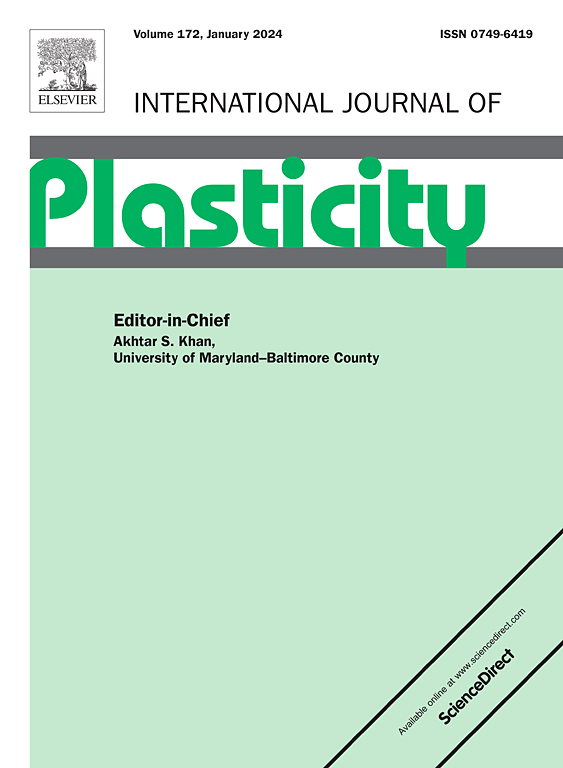Hydrogen-induced twin boundary passivation in multi-principal element alloy: a micropillar compression study
IF 12.8
1区 材料科学
Q1 ENGINEERING, MECHANICAL
引用次数: 0
Abstract
The ingress of nascent hydrogen into alloys can significantly alter their mechanical behaviors, leading to the well-known phenomenon of hydrogen embrittlement (HE) and catastrophic failure of structural components in service. As an emerging class of materials, some face-centered cubic multi-principal element alloys (MPEAs) exhibit unique resistance to HE, with the frequent presence of coherent twin boundaries (TBs) widely acknowledged as a contributing factor. However, the underlying mechanisms of TB-enhanced HE resistance remain under debate. Here, we selectively activate orientation-dependent TB-dislocation interactions by compressing [2]- and [01]-oriented CoCrFeNi MPEA micropillars containing an individual TB. This approach provides a benchmark for elucidating the hydrogen-induced deformation behaviors. An enhanced yield strength and orientation-dependent strain hardening are observed, attributed to hydrogen-induced TB passivation against slip transmission, with minimal impact on intragranular dislocation activities. Microstructural analysis reveals dislocation impediments at TBs and dislocation entanglements within the grains, confirming the hydrogen-induced TB passivation mechanism. These findings provide critical insights into the role of hydrogen in TB-facilitated plastic deformation and offer guidance for future studies aiming to comprehensively understand the HE resistance of MPEAs.


多主元素合金中氢致孪晶界钝化:微柱压缩研究
新生氢进入合金会显著改变合金的力学行为,导致众所周知的氢脆(HE)现象和使用中结构部件的灾难性失效。作为一种新兴的材料,一些面心立方多主元素合金(mpea)表现出独特的HE抗性,其常见的共格孪晶界(TBs)被广泛认为是一个促进因素。然而,结核病增强HE耐药性的潜在机制仍存在争议。在这里,我们通过压缩含有单个TB的[1¯1¯2]和[01¯1]取向的CoCrFeNi MPEA微柱,选择性地激活取向依赖的TB-位错相互作用。该方法为阐明氢致变形行为提供了一个基准。观察到屈服强度和取向相关应变硬化的增强,归因于氢诱导的TB钝化以防止滑移传递,对晶内位错活动的影响最小。显微组织分析显示,在结核结核处存在位错障碍和晶粒内存在位错纠缠,证实了氢诱导结核钝化机制。这些发现为氢在结核病促进的塑性变形中的作用提供了重要的见解,并为旨在全面了解mpea的HE抗性的未来研究提供了指导。
本文章由计算机程序翻译,如有差异,请以英文原文为准。
求助全文
约1分钟内获得全文
求助全文
来源期刊

International Journal of Plasticity
工程技术-材料科学:综合
CiteScore
15.30
自引率
26.50%
发文量
256
审稿时长
46 days
期刊介绍:
International Journal of Plasticity aims to present original research encompassing all facets of plastic deformation, damage, and fracture behavior in both isotropic and anisotropic solids. This includes exploring the thermodynamics of plasticity and fracture, continuum theory, and macroscopic as well as microscopic phenomena.
Topics of interest span the plastic behavior of single crystals and polycrystalline metals, ceramics, rocks, soils, composites, nanocrystalline and microelectronics materials, shape memory alloys, ferroelectric ceramics, thin films, and polymers. Additionally, the journal covers plasticity aspects of failure and fracture mechanics. Contributions involving significant experimental, numerical, or theoretical advancements that enhance the understanding of the plastic behavior of solids are particularly valued. Papers addressing the modeling of finite nonlinear elastic deformation, bearing similarities to the modeling of plastic deformation, are also welcomed.
 求助内容:
求助内容: 应助结果提醒方式:
应助结果提醒方式:


